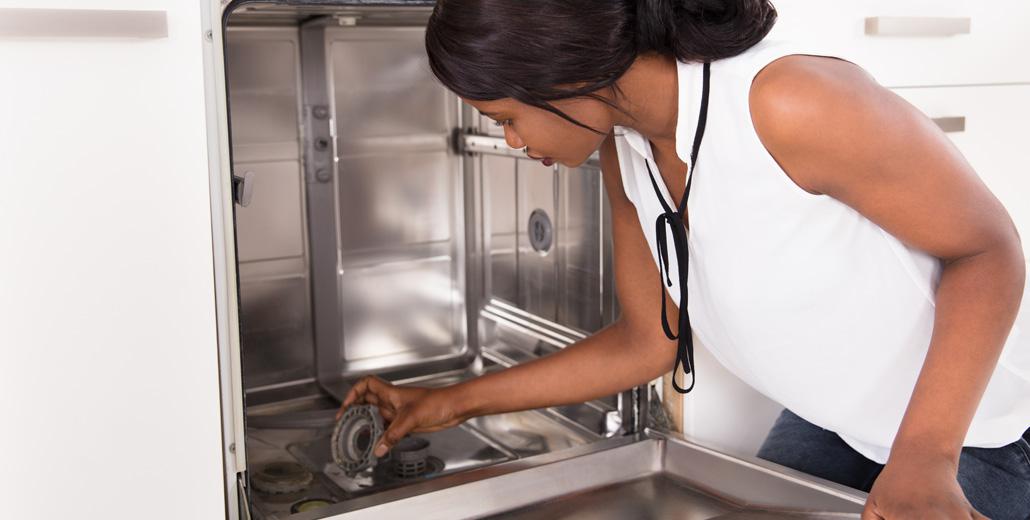
A backed-up dishwasher is pretty disgusting, but the good news is that it’s not usually a serious plumbing emergency. If you’re not sure what to do when your dishwasher won’t drain, use the following steps to see if you can fix it yourself.
Why Your Dishwasher Won’t Drain
Dishwashers sometimes clog up the same ways sinks and shower drains do, and usually for the same reasons (plus a few more).
Your dishwasher has hoses that connect to both the supply and the drain under the sink. Usually, the drain hose is connected to the garbage disposal, if you have one.
When hoses deteriorate with age, they can kink and block drainage. There may be food or paper debris stuck inside them, as well.
It’s easy to tell when your dishwasher won’t drain – you’ll open it up when it’s done running and find the bottom full of mostly dirty water.
Troubleshooting a Dishwasher That Won’t Drain
First, suspect that something is obstructing that drain that removes the water.
1. Run the wash cycle again
Very often, running the wash cycle again will clear any blockages preventing the dishwasher from draining. This often happens when someone has accidentally interrupted the wash cycle.
2. Garbage disposal
Dishwashers are usually designed and installed to discharge dirty water into the garbage disposal. So, if your garbage disposal is blocked with unprocessed debris, it will prevent the dishwasher from draining.
3. Check the air gap
Building codes often require the use of an air gap between the dishwasher and the drain. This prevents wastewater from backing up into your machine.
You’ll find the air gap located in a cylindrical fixture on or behind the sink. If there is water coming out of the air gap fixture when the washer is running, there is probably a clog in the drain hose between the dishwasher and the drain.
Remove the cap on the air gap and clean it with baking soda and water. Then replace it, ensuring it is tightened.
4. Clean the filter
You’ll find a filter screen over the top of the water outlet at the bottom of your dishwasher. Remove the screen and clean any debris from the screen.
Many dishwashers also have filters to prevent food debris from clogging the drain. In this case, remove any standing water by bailing it out first or using a shop vac.
Remove the filter screen and then remove the filter. Clean out the filter using the manufacturer’s directions. Then replace it and the screen.
Regularly cleaning out the filter will prevent clogs and backups in the future, too. You’ll have to run the cycle again to engage the drain pump since it doesn’t drain via gravity like sink and tub drains.
5. Clean the drain lines
If cleaning the filter and filter screen doesn’t remove the water from your dishwasher, try cleaning the drain internally with a mild solution of baking soda and vinegar.
Do not use commercial drain cleaners, as the highly alkaline solution damages your dishwasher.
Mix a cup of household white vinegar and a cup of baking soda and pour these into the bottom of the dishwasher. Don’t worry if there is still standing water in the bottom of the tub.
The chemical reaction caused by these ingredients can remove some of the grease and gunk that block the drain. Allow them to sit and work for 20 to 30 minutes.
If you notice the water is starting to drain, add in a bucket of hot water to loosen the clogs and move the solution further into the drain.
5. Assess the drain hose
Dishwasher drain hoses become corroded by hard water buildup or simply obstructed by food debris. They can also become kinked. Badly damaged hoses should be replaced.
If your drain hose is otherwise in good shape, you can unclog it yourself.
Disconnect power from the dishwasher and remove the front panel. Disconnect the hose from the drain pump and check it visually for clogs.
Remove any blockages with compressed air or hot water and a wire. You can also replace it with a new one if the clog is impossible to remove without damaging the hose.
6. Consider mechanical failure
If none of the above steps work to unclog your dishwasher drain, make note of the sound the appliance makes when operating. If you hear humming and clicking noises, but don’t hear the water moving within, it may be time to replace the machine or call in a professional.
Sometimes the drain pump fails, which means the machine simply cannot remove the standing water in the machine.
If your dishwasher won’t drain and you’ve exhausted all the DIY possibilities, make an appointment with one of our 24 hour emergency plumbers in Nashville.
